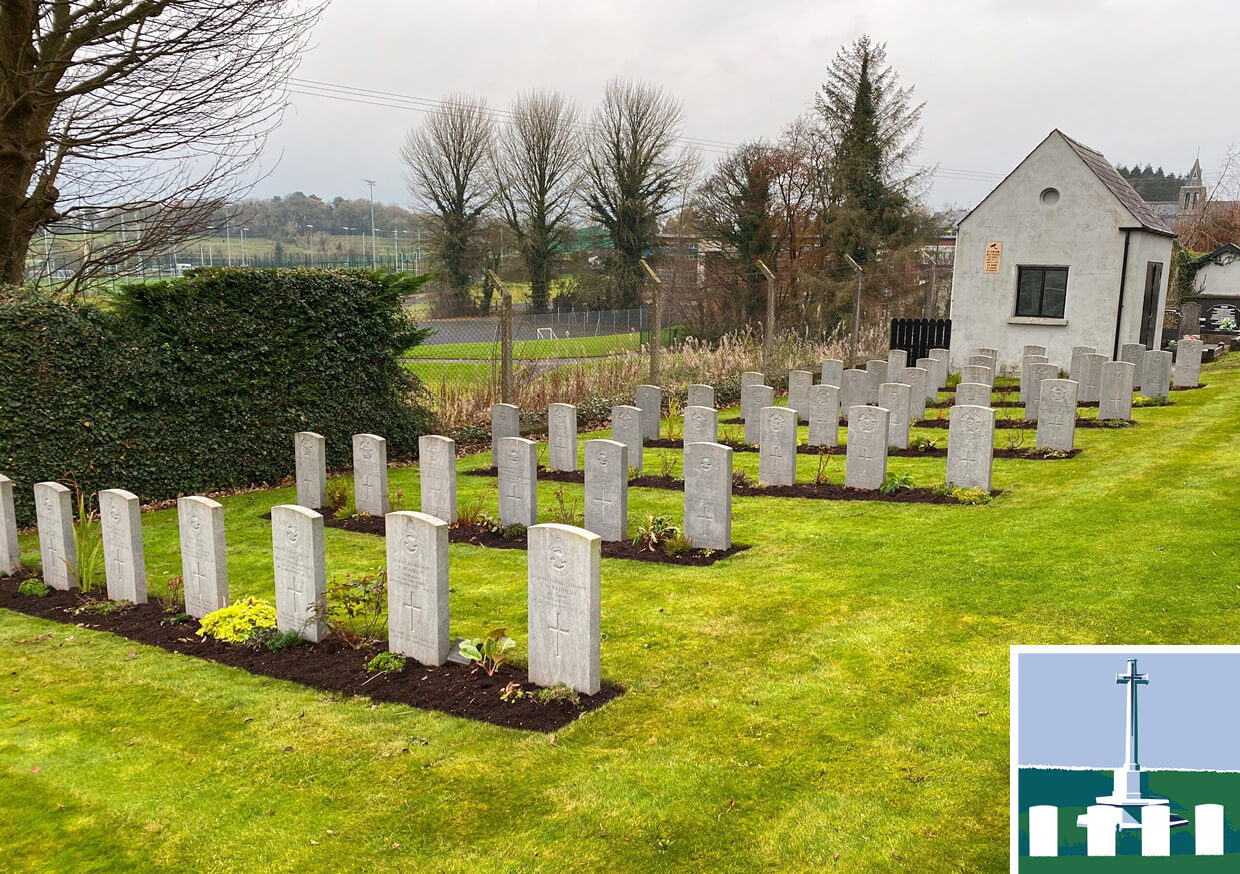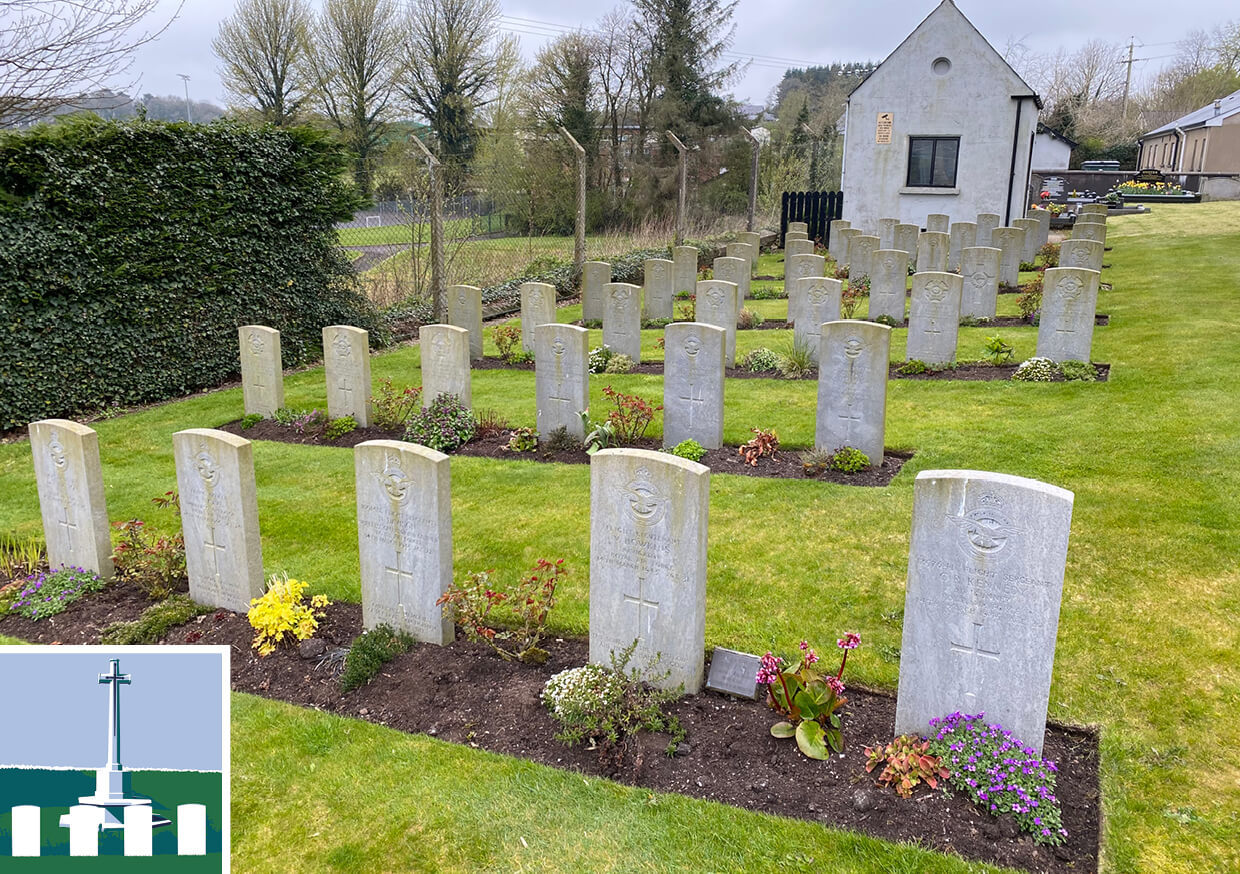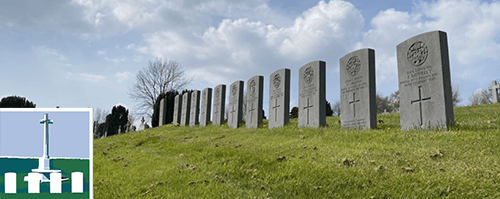Irvinestown Church of Ireland Churchyard
In this small town in County Fermanagh, discover the largest group of Second World War air force dead in all of Northern Ireland. How did a small country churchyard come to be the final resting place of 74 young airmen, more than half of them thousands of miles from their homes in Australia, Canada and New Zealand?

The First World War left only three war graves in the little town of Irvinestown, one each in the old graveyard, the Roman Catholic (Sacred Heart) churchyard, and the Church of Ireland churchyard. All of these servicemen came from the area and either died at home of service-related causes or died elsewhere in the UK and were brought home by their families for burial.
In 1914-1918, men left Irvinestown for the war – in 1941 the Second World War came to Irvinestown. Lough Erne became a base for RAF Coastal Command flying boats fighting in the Battle of the Atlantic, the struggle to protect vital sea lanes which lasted for the duration of the war. Many hundreds of air force men and women lived and worked at RAF Castle Archdale, Killadeas and St Angelo. Airmen of Coastal and Bomber Commands killed in crashes were brought to this war cemetery for burial, along with those who died in accidents or of other causes while serving in this area. One soldier was laid to rest here by his family in 1946; we commemorate 76 servicemen here today, two of whom remain unidentified.
Find out more
The Battle of the Atlantic began the moment war was declared in September 1939. German U-boats attacked Allied ships, sinking hundreds of merchant vessels, threatening to starve Britain’s people and her war effort. RAF Coastal Command needed to base aircraft as close as possible to the North Atlantic to help escort convoys, carry out anti-submarine warfare and perform air sea rescues – Lough Erne was scouted as a potential base for RAF flying boats in December 1940. It was as far west as they could go within the UK, but neutral Irish territory lay between the lake and international waters. Planes based in Northern Ireland had to avoid Irish airspace by flying north before they could fly west, wasting fuel and shortening their patrols. Serious pressure was put upon the Irish government by Britain and the United States and in January 1941 a secret agreement was made permitting aircraft to overfly a narrow corridor of Ireland to reach the North Atlantic from Lough Erne. RAF stations sprang up and the first operational flight through ‘the Donegal Corridor’ took place in February 1941.

A Short Sunderland of No.201 Squadron taking off from Lough Erne © IWM HU 91908
Fighting ‘the U-boat menace’ was vital but costly. In March 1941, the first burials of the Second World War were made in the Church of Ireland churchyard: six men of No. 240 Squadron. On their first operational patrol from Lough Erne, in terrible visibility, their Catalina crashed into a hillside in County Leitrim killing all eight men on board. Although neutral, Irish authorities permitted the return of bodies to Northern Ireland. Many of those buried in Irvinestown would come from crash sites across the border. Often only part of a crew is in the Church of Ireland churchyard: some families resident in the UK arranged to have their loved ones brought home, while those of Roman Catholic faith remaining in Irvinestown were buried at Sacred Heart.

A downed bomber crew climb onboard their rescuing Sunderland © AWM SUK10482
By mid-October 1943, a second war graves plot was necessary. The IWGC’s Inspector for Northern Ireland during and after the war reported that when a funeral of several men took place ‘the whole town closed up as on a Sunday’ so people could pay their respects to the passing procession. On 16 August 1944, the ninth such procession would pass through Irvinestown. Carl Schaefer, an official war artist with the Royal Canadian Air Force, later sketched a moment in the churchyard.

They were burying Flight Lieutenant ‘Cam’ Devine of Orillia, Ontario and Flying Officer Wilkinson of Toronto, Ontario (a third man, Pilot Officer Forrest, was interred at Sacred Heart). All three had died on 12 August when their Sunderland crash landed near Corlea, County Donegal. Fully laden for a long anti-submarine patrol, an engine failed not long after take-off from RAF Castle Archdale. Devine – pilot and captain – fought to keep the plane aloft to safely jettison depth charges and fuel and then to put the aircraft down in a way that might save his crew. He, co-pilot Wilkinson, and Forrest, were killed instantly, but eight men survived.

Devine’s crew, No.422 Squadron. Devine is seated in the centre. (With thanks to James Stewart)
By March 1946, the 74 airmen’s graves were settled enough to be sown with grass. Our Inspector wrote ‘the local people have taken the greatest possible interest and “pride” that so many “heroes of the RAF” were buried in their town’ and he would often find freshly cut flowers upon graves when he came to inspect. In 1947 the Commission’s Principal Architect, Edward Maufe, submitted a layout for the site, placing a Cross of Sacrifice of Irish limestone in Plot I and including a dedicated entrance and pathway to connect the two war graves plots. The Cross and headstones were completed by 1951. A new entrance feature, seat and pathway were added in 1957-58, finishing a beautiful corner of Fermanagh for young men from across the UK and Australia, Canada and New Zealand to rest in forever.


Visit Irvinestown Church of Ireland Churchyard

During both World Wars Belfast was an important hub of military activity. Busy with Merchant Navy and Royal Navy ships, it was from here that many service personnel left Ireland to serve overseas.
Belfast City Cemetery
Londonderry City Cemetery was opened in 1853. Amongst the 70,000 civilian burials are 194 Commonwealth war graves of the First and Second World War.
Londonderry (Derry) City Cemetery
